A version of this post was originally published on TKer.co.
Stocks rallied last week. The S&P 500 surged 4.7% in what was the biggest weekly gain since June. The index is now up 4.9% from its October 12 closing low of 3,577.03. However, it’s still down 21.8% from its January 3 closing high of 4,796.56.
When markets are as volatile as they have been, it’s easy to get caught up in all the things that are going right or wrong at the moment.
And while there’s nothing wrong with keeping current on the present, this is not the right mindset for long-term investors in stocks.
“Do not invest in the present,” Stanley Druckenmiller, the legendary hedge fund manager currently running Duquesne Family Office, said. “The present is not what moves stock prices.”
Druckenmiller noted that this is his No. 1 piece of advice for new investors.
In a Sept. 22 episode of the “How Leaders Lead” podcast, Druckenmiller expanded on this (via The Transcript):
“I learned this way back in the 70s from my mentor [Speros] Drelles. I was a chemical analyst. When should you buy chemical companies? Traditional Wall Street is when earnings are great. Well, you don’t want to buy them when earnings are great, because what are they doing when their earnings are great? They go out and expand capacity. Three or four years later, there’s overcapacity and they’re losing money. What about when they’re losing money? Well, then they’ve stopped building capacity. So three or four years later, capacity will have shrunk and their profit margins will be way up. So, you always have to sort of imagine the world the way it’s going to be in 18 to 24 months as opposed to now. If you buy it now, you’re buying into every single fad every single moment. Whereas if you envision the future, you’re trying to imagine how that might be reflected differently in security prices.”
This is theoretically sound as theory says the value of a stock should reflect the present value of a company’s future cash flows.
Druckenmiller is talking about picking stocks. But I think his still serves as a good framework for broadly diversified investors processing macro information coming from economic data and earnings announcements.
The labor market is strong 💪
One big theme of late has been the strength of the labor market. Specifically, the elevated level of job openings signals the need to hire, and the depressed level of layoff activity signals the desire to hang on to employees.
Consider these quotes from recent earnings calls (via The Transcript and RBC Capital Markets):
-
“I would note at this point, based on our Q3 performance, we have seen net hiring among our customers. So, we have not yet seen an emergence of recessionary impact in our commercial book of business.” – UnitedHealth Group
-
“We’re seeing positive staffing trends with 11 straight weeks of net pharmacist head count increases.” – Walgreens Boots Alliance
-
“We are not making major cutbacks across the plant…We don’t see any reason for great draconian measures.“ – Morgan Stanley
Bloomberg reported that Goldman Sachs, Morgan Stanley, Citigroup, JPMorgan Chase, and Bank of America all increased their headcounts in Q3.
Similarly, the past week’s high-level economic reports broadly confirmed these anecdotes. Initial claims for unemployment insurance benefits fell last week and continue to trend at low levels. The Federal Reserve’s October Beige Book said that employment “continued to rise at a modest to moderate pace in most Districts.“ Manufacturing business surveys from the NY Fed and Philly Fed each indicated employment was up in their respective regions in October.
What all this staffing means for the future 🤔
The resilient labor market suggests that demand in the economy continues to be robust.
But that’s the present.
What about the future? What does this mean 18 to 24 months down the road?¹
I think there are at least two basic scenarios to consider.
-
Bearish scenario: The economic lull we’re in eventually evolves into recession and we have an extended period of weak demand. Companies that are currently increasing hiring or refusing to layoff workers could see a sharp drop in earnings as weak revenue runs into high labor costs, and profit margins get crushed.
-
Bullish scenario: The economic lull we’re in proves short-lived, and growth soon accelerates again. Companies that held on to employees or grew head counts today may not need to compete aggressively for workers in what should be an increasingly competitive labor market. Because they already have extra capacity, these companies will benefit from operating leverage as revenue growth comes with expanding profit margins, which amplifies earnings growth.
What actually happens depends on where the economy heads, which itself is not an easy thing to predict.
But I can’t help but think that given the current state of things, the outlook favors the more bullish scenario. Why? Because the message from the economic data and corporate America is that demand continues to outpace the capacity to supply. Consider this quote from the Fed’s October Beige Book: “Overall labor market conditions remained tight, though half of Districts noted some easing of hiring and/or retention difficulties. Competition for workers has led to some labor poaching by competitors or competing industries able to offer higher pay.“
And consider this from Domino’s: “Staffing remains a constraint, but my confidence in our ability to solve many of our delivery labor challenges ourselves has grown over the past few quarters.”
So demand would have to fall considerably before companies find themselves with too much costly idle labor.
Let’s check back in 18 to 24 months.
The bottom line: Stocks are a discounting mechanism, pricing in what’s expected to happen and not what’s currently happening. Whether it’s 18-24 months out or 20 years out, being in the stock market is about betting on a better future that has yet to be realized and priced in. Now, it’s not particularly clear what’s to come in 18-24 months. (The lesson of the past 18-24 months is that things can certainly go wrong.) But long-term history is very consistent in teaching us that the long-term future always turns out to be better than what we are experiencing today.
–
More from TKer:
Reviewing the macro crosscurrents 🔀
There were a few notable data points from last week to consider:
🚨 Recession warning sign. The Conference Board’s Leading Economic Index2 fell in September. The six-month average change was -0.5%, a reading that’s historically associated with recessions. From The Conference Board’s Ataman Ozyildirim: “The US LEI fell again in September and its persistent downward trajectory in recent months suggests a recession is increasingly likely before yearend. The six-month growth rate of the LEI fell deeper into negative territory in September, and weaknesses among the leading indicators were widespread. Amid high inflation, slowing labor markets, rising interest rates, and tighter credit conditions, The Conference Board forecasts real GDP growth will be 1.5% year-over-year in 2022, before slowing further in the first half of next year.”
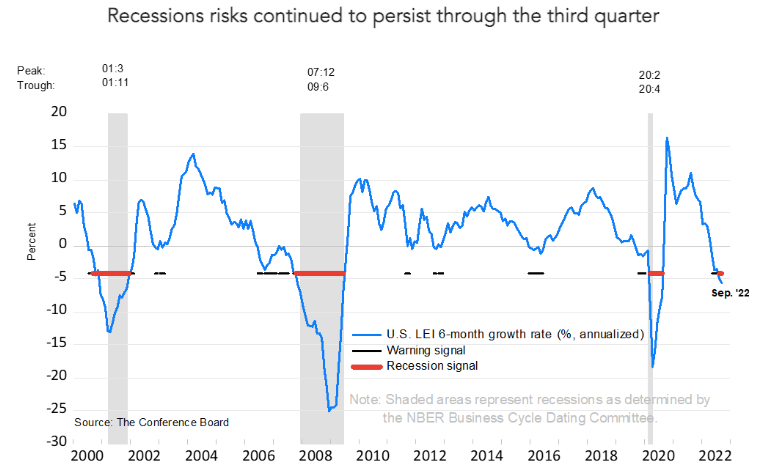
Meanwhile, Bloomberg economists estimate there’s a “100%” probability that the U.S. economy will have entered a recession by October 2023.
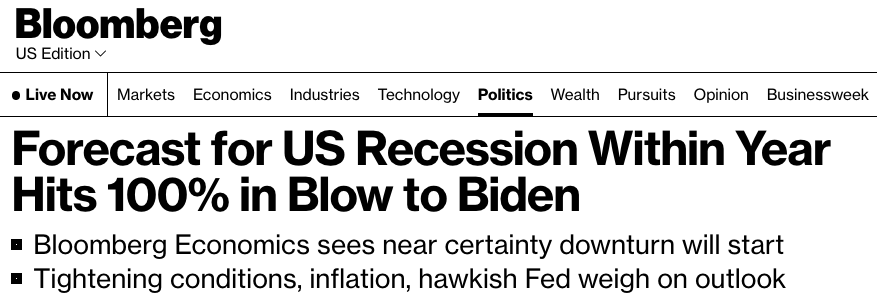
📈 Mortgage rates keep climbing. According to Freddie Mac, the average 30-year fixed-rate mortgage rose to 6.94%, the highest level since April 2002.
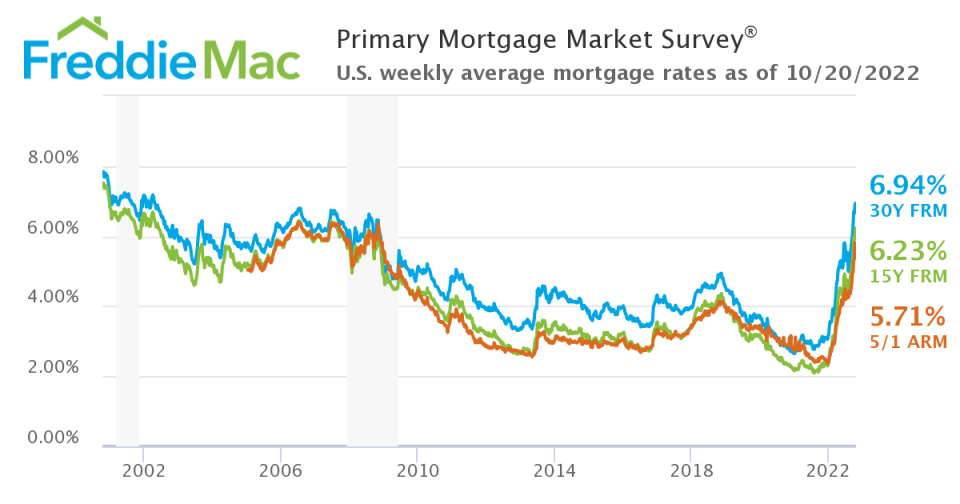
📉 $2,500 monthly mortgage payment gets you less. Surging mortgage rates and still-high home prices have made buying a home unaffordable for many. According to Bloomberg’s Michael McDonough, a $2,500 monthly mortgage payment could get you a $756k home in February 2021. Today, it gets you a $455k home.
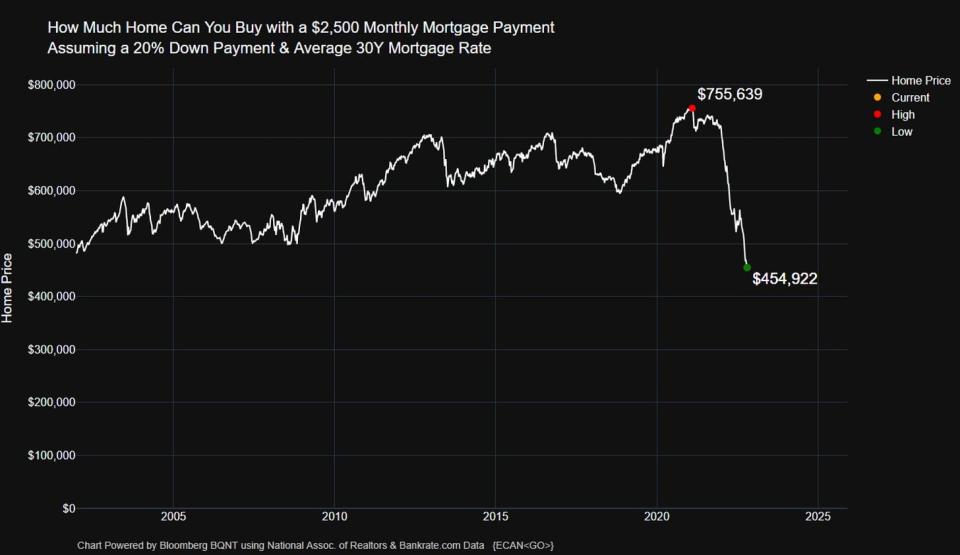
🏘 Home sales continue to fall. According to the National Association of Realtors, sales of previously owned homes fell 1.5% in September to an annual rate of 4.71 million units. From NAR chief economist Lawrence Yun: “The housing sector continues to undergo an adjustment due to the continuous rise in interest rates, which eclipsed 6% for 30-year fixed mortgages in September and are now approaching 7%. Expensive regions of the country are especially feeling the pinch and seeing larger declines in sales.“
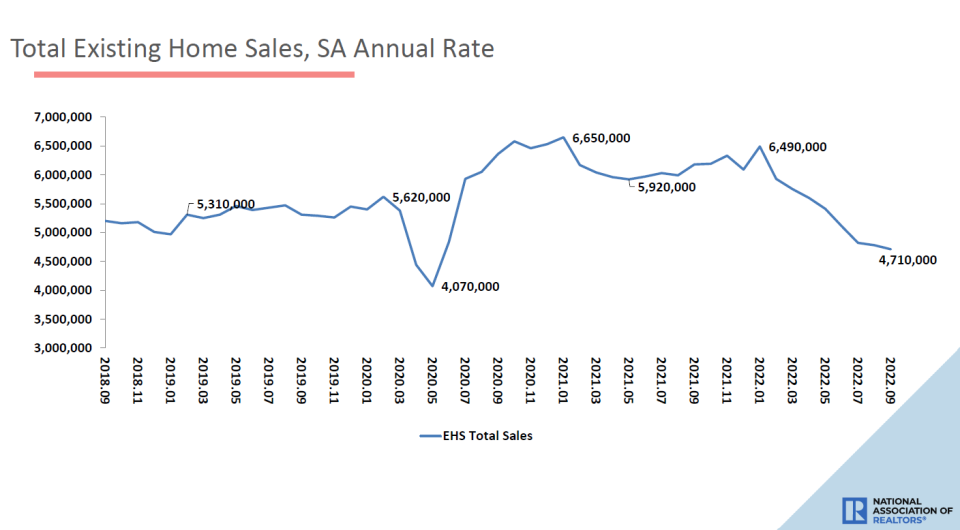
🏘 Home prices continue to fall. The median price of homes sold fell to $384,800 in September, down from the June high of $413,800. However, the median price is still 8.4% higher from last year’s level. To better understand why this government inflation data appear to lag these trends, read this.
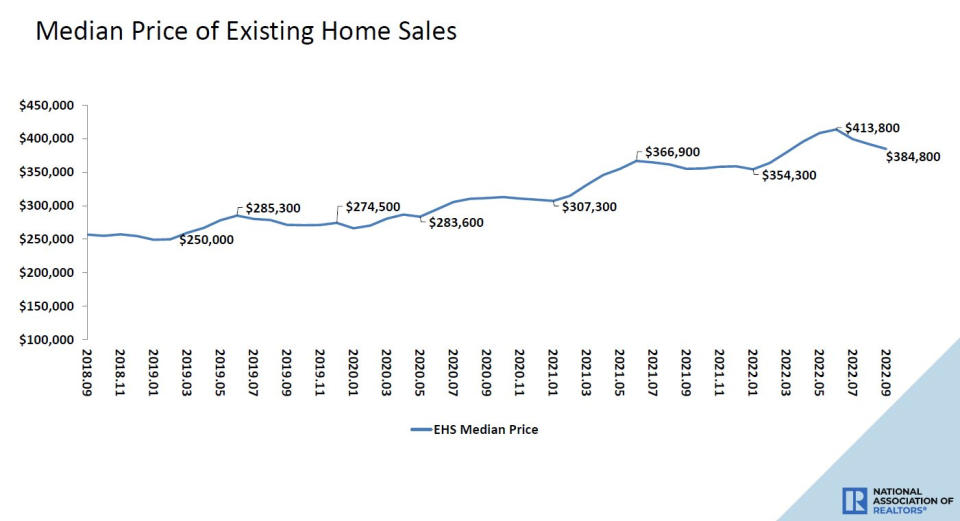
🔨 Home construction continues to cool. According to the Census Bureau, the pace of housing starts September fell 8.1% from August and 7.7% from year ago levels. The pace of new building permits increased 1.4% from the month prior, but was down 3.2% from a year ago.
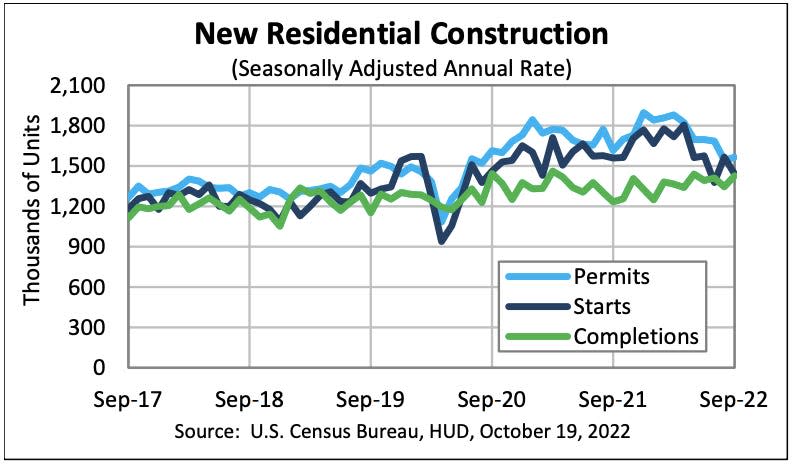
🛠 Builder sentiment goes deeper into the dumps. From the NAHB: “In a further signal that rising interest rates, building material bottlenecks and elevated home prices continue to weaken the housing market, builder sentiment fell for the 10th straight month in October and traffic of prospective buyers fell to its lowest level since 2012 (excluding the two-month period in the spring of 2020 at the beginning of the pandemic).“ From NAHB chief economist Robert Dietz: “While some analysts have suggested that the housing market is now more ‘balanced,’ the truth is that the homeownership rate will decline in the quarters ahead as higher interest rates and ongoing elevated construction costs continue to price out a large number of prospective buyers.“
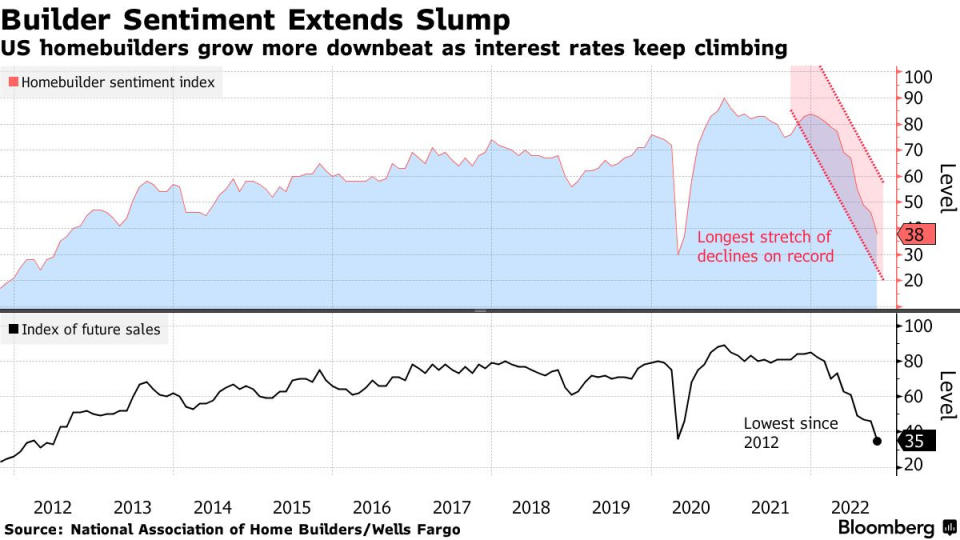
🛠 Manufacturing has been holding up. Industrial production activity increased by 0.4% month over month in September.

🛠 But manufacturing surveys are more cautious. According to the New York Fed’s October Empire State Manufacturing Survey, manufacturing activity is contracting in the New York area.
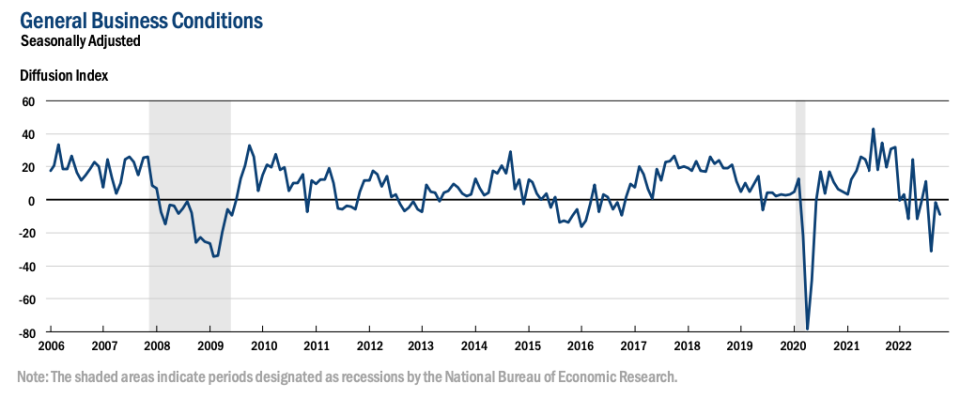
And according to the Philly Fed’s…
Read More:Stanley Druckenmiller’s No. 1 piece of advice for novice investors
2022-10-23 17:32:32
